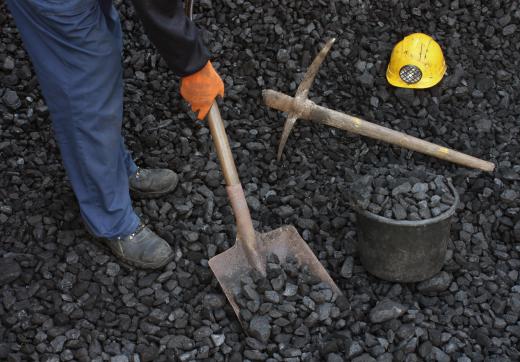What is Lignite?
Lignite is a brownish-black fossil fuel that is used primarily for electric power generation. Considered to be a low-ranking type of coal, the fuel is usually categorized by geologists as a recent fuel. Typically, it fits between peat and sub-bituminous coal on geological solid fuel ranking scales. Lignite coal is burnable and may also be referred to as brown coal, earth coal, or Rosebud coal.
Geologically, lignite is believed to be relatively young in age. Some geologists estimate that it formed roughly 251 million years ago, during the Mesozoic and Cenozoic eras. In general, the fuel is thought to have been formed from peat at shallow depths and at temperatures less than 212°F (about 100°C). Distinguishable plant remains can often be found in brown coal. Additionally, the fuel frequently holds patterns from the wood from which it was derived.

Brown coal has a relatively high volatile matter content. Consequently, it can be converted into liquid petroleum and gas products more easily than higher quality kinds of coal, such as bituminous coal or anthracite. The fuel is also characterized by a high inherent moisture content, up to 75% in some cases. Lignite ash content generally ranges between six and 19% while its carbon content makes up roughly 25% to 30%.
Brown coal can be more difficult to use than other types of coal. For instance, it can be susceptible to spontaneous combustion, making transporting and storing it problematic. Due to its transportation limitations, brown coal is often burned in a utility plant that has been set up near a lignite mine. The fuel’s high water content also makes disintegration more likely, further reducing its worth. As a result of these limitations, brown coal is usually not traded on the world market as widely as higher grade coals.
There are a few major types of brown coal, which are usually categorized by structure. Xyloid coal, also called fossil wood or bituminous wood, has the fibrous structure of wood. Fibrous lignite often looks like peat in appearance and is comprised of approximately 50% water and 30% ashes. Pitchy lignite, on the other hand, is more similar to coal in appearance.
Lignite mining occurs worldwide throughout Europe, Australia, the United States, and Russia. Brown coal production is more common in areas where other types of fuel are scarce. Some environmental concerns surround lignite mines because pollution emissions from a lignite plant are usually greater than emissions from other types of coal plants.
AS FEATURED ON:
AS FEATURED ON:











Discussion Comments
@indemnifyme - Well, the spontaneous combustion can't be too much of a problem. I mean, I've never heard anything about a lignite explosion on the news, and it sounds like you haven't either!
I'm actually more concerned about the emissions from this stuff. If the emissions from lignite are so much more than from other types of coal, I really don't think this stuff should be used!
Wow! Spontaneous combustion? I thought that was just a myth. I can't believe there is a substance out there that actually does this, and that it's used for fuel! Sounds pretty dangerous to me.
It makes sense that this stuff is usually not transported far. However, I wouldn't even want to drive for five minutes in a vehicle carry lignite!
Post your comments